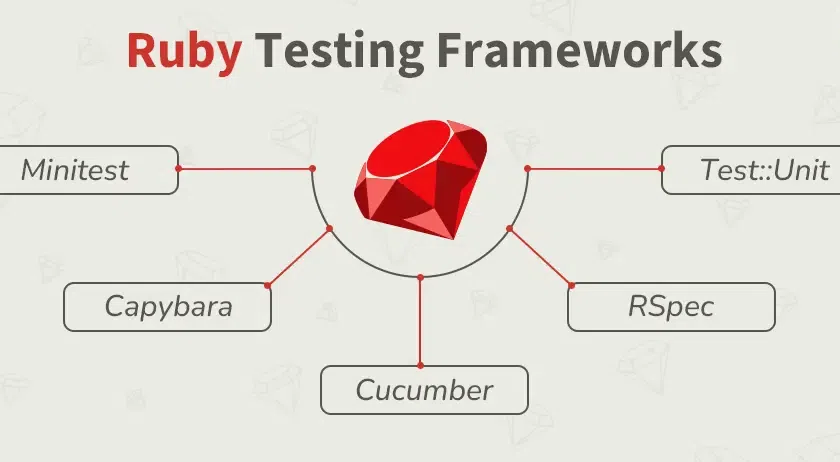🚀 Mastering Ruby on Rails Testing: TDD vs BDD, Rspec, Minitest & More! 🧪
🚀 Mastering Ruby on Rails Testing: TDD vs BDD, Rspec, Minitest & More! 🧪
Testing is the backbone of a robust Rails application. Whether you’re a beginner or an experienced developer, understanding different testing approaches can save you from bugs and headaches! In this blog, we’ll explore:
✅ TDD vs BDD — What’s the difference?
✅ Types of Tests — Model, Controller, View, Feature, and more!
✅ Popular Testing Gems — Rspec, Minitest, Capybara, FactoryBot, and more!
✅ Examples — Real-world test cases to get you started!

🔍 TDD vs BDD: What’s the Difference?
1. Test-Driven Development (TDD) 🧪
TDD follows a “Test-First” approach:
- Write a failing test (Red phase).
- Write minimal code to pass the test (Green phase).
- Refactor the code while keeping tests passing (Refactor phase).
Example (Using Minitest):
# test/models/user_test.rb
require 'test_helper'
class UserTest < ActiveSupport::TestCase
test "should not save user without email" do
user = User.new
assert_not user.save, "Saved user without email!"
end
end2. Behavior-Driven Development (BDD) 🎭
BDD focuses on user behavior and collaboration between developers, testers, and business stakeholders. It uses human-readable descriptions.
Example (Using Rspec + Capybara):
# spec/features/user_login_spec.rb
require 'rails_helper'
RSpec.feature "User Login", type: :feature do
scenario "User logs in successfully" do
visit login_path
fill_in "Email", with: "test@example.com"
fill_in "Password", with: "password"
click_button "Log In"
expect(page).to have_text("Welcome back!")
end
endKey Difference:
- TDD = Developer-centric (tests functionality).
- BDD = Business-centric (tests user experience).
🛠 Types of Tests in Rails
1. Model Tests (Unit Tests) 📦
Tests business logic in models.
Example (Rspec):
# spec/models/user_spec.rb
RSpec.describe User, type: :model do
it "is valid with valid attributes" do
user = User.new(email: "test@example.com", password: "secret")
expect(user).to be_valid
end
end2. Controller Tests 🎮
Tests controller actions & responses.
Example (Minitest):
# test/controllers/users_controller_test.rb
class UsersControllerTest < ActionDispatch::IntegrationTest
test "should get index" do
get users_url
assert_response :success
end
end3. View Tests 👀
Tests rendered HTML (rarely used, but helpful in some cases).
Example (Rspec):
# spec/views/users/index.html.erb_spec.rb
RSpec.describe "users/index", type: :view do
it "displays all users" do
assign(:users, [User.create!(name: "John")])
render
expect(rendered).to include("John")
end
end4. Feature Tests (End-to-End) 🌐
Tests user interactions (using Capybara).
Example (Rspec + Capybara):
# spec/features/user_signup_spec.rb
RSpec.feature "User Sign Up", type: :feature do
scenario "User signs up successfully" do
visit signup_path
fill_in "Email", with: "new@example.com"
fill_in "Password", with: "password"
click_button "Sign Up"
expect(page).to have_content("Welcome!")
end
end5. Request Tests (API Testing) 📡
Tests API endpoints.
Example (Rspec Request Spec):
# spec/requests/api/users_spec.rb
RSpec.describe "API Users", type: :request do
it "returns a list of users" do
get "/api/users"
expect(response).to have_http_status(:ok)
expect(JSON.parse(response.body)).not_to be_empty
end
end💎 Must-Know Testing Gems
- Rspec � — BDD testing framework
- Minitest 🧪 — Lightweight built-in testing
- Capybara 🕷️ — Feature testing (simulates browser)
- FactoryBot 🏭 — Replaces fixtures with factories
- Faker 🎭 — Generates fake test data
- Shoulda-Matchers 🔍 — Simplifies model tests
- Database Cleaner 🧹 — Cleans DB between tests
- VCR 📼 — Records HTTP interactions
- SimpleCov 📊 — Test coverage reports
Example Gemfile Setup:
group :test do
gem 'rspec-rails'
gem 'capybara'
gem 'factory_bot_rails'
gem 'faker'
gem 'shoulda-matchers'
gem 'database_cleaner-active_record'
end🎯 Final Thoughts
- TDD is great for ensuring code correctness.
- BDD improves collaboration and user experience.
- Rspec is more expressive, while Minitest is simpler.
- Always test critical paths (models, controllers, features).
🚀 Start testing today and build unbreakable Rails apps!
🔗 Got questions? Drop them in the comments!
#RubyOnRails #Testing #Rspec #Minitest #TDD #BDD #WebDevelopment
Comments
Post a Comment